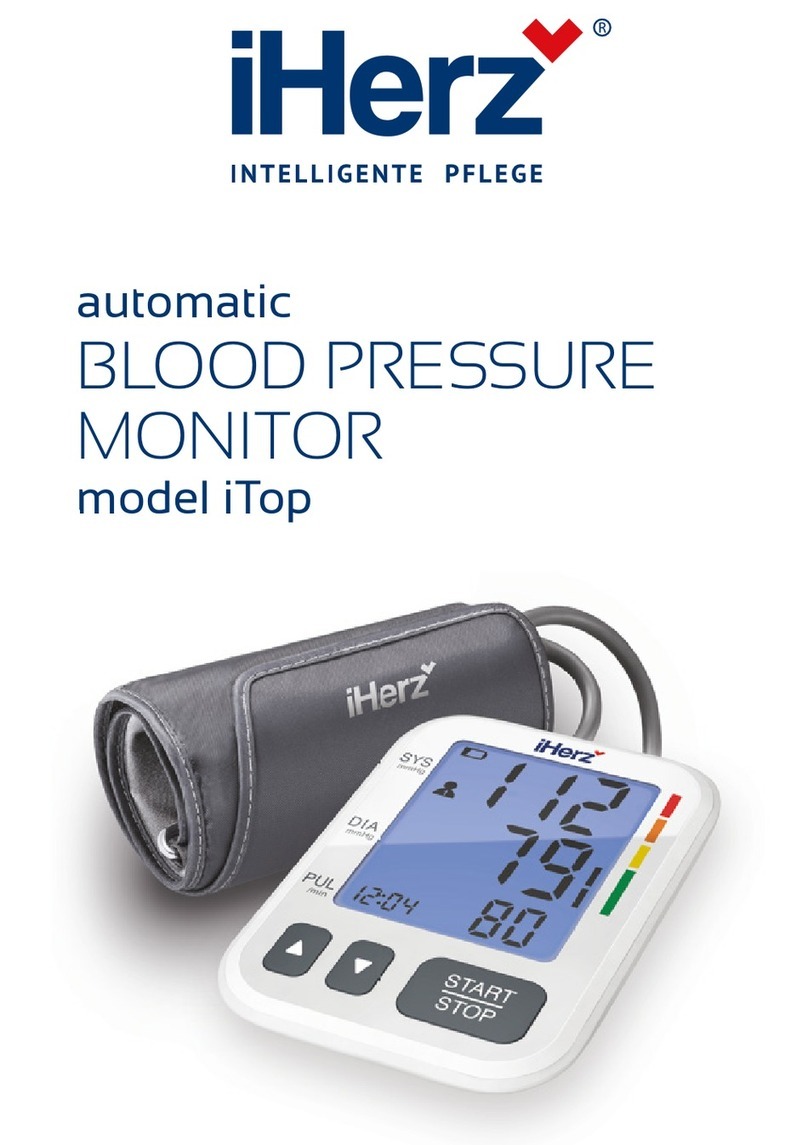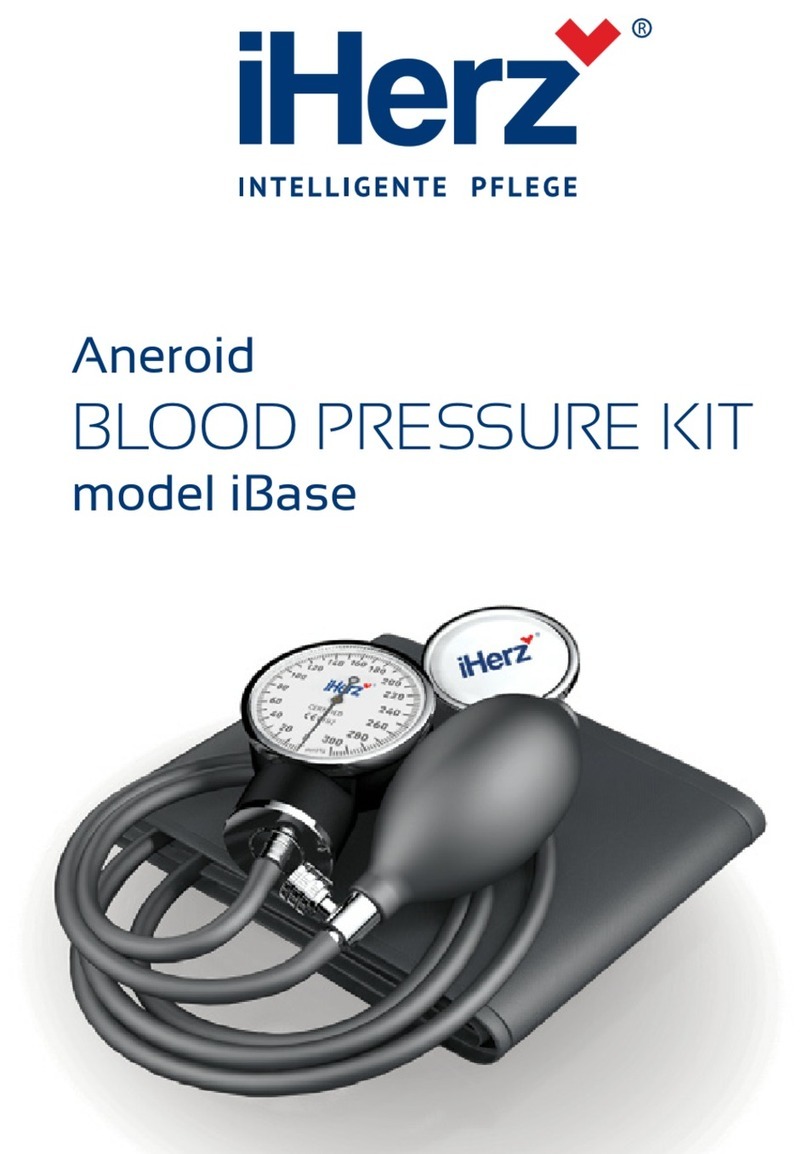iHerz iMove User manual

automatic
BLOOD PRESSURE
MONITOR
model iMove
m
o
d
e
l
i
Mov
e

2
DEAR TM IHERZ®AUTOMATIC BLOOD
PRESSURE MONITOR OWNER
Thank you for choosing Automatic Blood Pressure Monitor TM iHerz®
model iMove. We are sure that having appraised worthily the high
quality and reliability of this device you will become a regular user of
the products of Italian Trademark TM iHerz®.
Before starting to use this device, please, study the user’s manual
carefully. The user’s manual oers all information you need to meas-
ure your blood pressure and pulse correctly. For all questions con-
cerning the device, please, contact your local distributor or TM iHerz®
service centre in your country.
ATTENTION
This blood pressure monitor is designed to carry out self-control over
blood pressure but NOT to make self-diagnosis of hypertension/
hypotension. Please, DO NOT diagnose by yourselves basing on
the measurement results obtained with the blood pressure monitor.
Please, DO NOT execute self-treatment of high/low blood pressure
and DO NOT change the methods prescribed without consulting your
doctor.
Type BF applied part.
Read the instructions carefully before using this device.

3
EN
IMPORTANT INFORMATION ON
BLOOD PRESSURE AND ITS MEAS-
UREMENT
What Is Blood Pressure?
Blood pressure is the pressure that your
blood extends to the vascular walls.
Blood pressure is necessary to provide
for constant blood ow inside the body.
Thanks to it the cells get oxygen that
provides for their normal functioning. The
heart performs the function of a «pump»,
sending blood to the blood vessels. Each
heart beat creates a certain level of the
blood pressure.
There are 2 kinds of blood pressure: a
systolic (upper) one, which corresponds
to the heartbeat pushing blood into the arteriae; and a diastolic (lower)
one, which means the blood pressure between two heartbeats.
Blood pressure is subject to uctuations during the day even in healthy
people. The uctuations are inuenced by a number of factors - time of
day, person’s condition, physical or mental activity, environment, etc.
Day-Night Fluctuations of the Blood Pressure
An increase of blood pressure increases the burden onto the heart,
aects blood vessels making their walls thick and less elastic.
170
160
150
140
130
120
110
100
90
80
70
60
50
40
8.00 10.00 12.00 14.00 16.00 18.00 20.00 22.00 24.00 2.00 4.00 6.00 8.00
DIA blood pressure
SYS blood pressure
Time (hours)
mmHg

4
One of the features of the hypertension is its ability to remain unno-
ticed for the patient at its early stages. That’s why the self control of
the blood pressure is so important. With the illness progressing, head-
aches and regular dizziness appear, the sight declines, the function-
ing of vitals (encephalon, heart, kidneys, blood vessels) breaks down.
Without special treatment the complications of hypertension might be
kidney damages, breast-pang, paralytic stroke, aphasia, dementia,
heart attack and stroke.
Which values are normal?
The world standard as for the norms of the blood pressure is the
Classication* of the World Health Organization (WHO):
Category
Systolic
Blood Pressure
(mmHg)
Diastolic
Blood Pressure
(mmHg)
Blood pressure too low < 100 < 60
Blood pressure optimum 100 - 119 60 - 79
Blood pressure normal 120 - 129 80 - 84
Blood pressure slightly high 130 - 139 85 - 89
Blood pressure too high 140 - 159 90 - 99
Blood pressure far too high 160 - 179 100 - 109
Blood pressure dangerously
high
≥ 180 ≥ 110
* Printed with curtailments.
• The diagnosis of hypertension requires from the patient to combine
medical treatment prescribed by the doctor and mode of life cor-
rection.
• People with normal pressure and high normal pressure are recom-
mended to carry out self-control of their tension in order to timely
take measures to decrease the blood pressure level down to the
optimal one without using any medications.
• For people more than 50 years old high level of systolic blood pres-

5
EN
sure (higher than 140 mmHg) is more crucial than diastolic pressure.
• Even with blood pressure being normal, people run the bigger risk of
hypertension development with advancing age.
ATTENTION
If you have normal results of blood pressure measured under calm
conditions but your results are excessively high when measured under
the conditions of physical or mental exhaustion, this might be a sign
of so called brittle (that is unstable) hypertension. If you suspect that,
please, consult your doctor.
When measured correctly, if diastolic blood pressure is more than 120
mmHg, it is necessary to call the doctor immediately.
ADVANTAGES OF AUTOMATIC
BLOOD PRESSURE MONITOR
MODEL IMOVE
Blood Pressure Rate Indicator
Blood pressure rate indicator is located along left side of the display.
The classication corresponds to 6 ranges described in the table of
the section «Which values are normal?». After the measurement
there appears the dotted line in the left part of the display opposite
the zone to which the result of the measurement corresponds: green
zone - optimal blood pressure, yellow - elevated, orange - too high,
red - dangerously high. This function helps you to self-orient in the
measurement results.
Irregular Heartbeat Detection Technology
An irregular heartbeat is detected when a heartbeat rhythm varies
while the unit is measuring the systolic and diastolic blood pressure.
During each measurement, the monitor records all the pulse intervals
and calculate the average ; if there are two or more pulse intervals
,the dierence between each interval and the average is more than
the average value of ±25% , or there are four or more pulse intervals
,the dierence between each interval and the average is more than the
average value of ±15%,the irregular heartbeat symbol appears on the
display when the measurement results are appear.
Table of contents
Other iHerz Blood Pressure Monitor manuals




















